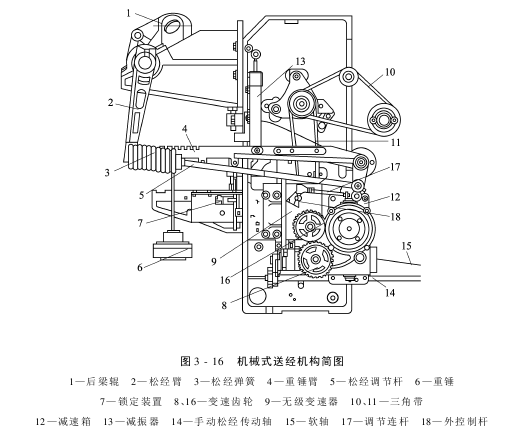Let-off mechanism (mechanical semi-positive let-off mechanism)
1. The basic structure of the warp let-off mechanism
For the mechanical positive warp let-off mechanism, there are differences in different models of water-jet looms, but they are similar. Now take a certain model of loom as an example, as shown in Figure 3-16.

2. Warp yarn delivery device
When the loom is running, The power is transmitted from the V-belt pulley on the pump camshaft to the input shaft of the continuously variable transmission 9 through the V-belts 10 and 11. After being changed by the internal mechanism of the continuously variable transmission, it is output from the output shaft and passes through the transmission gears 16 and 8 and the bevel gear. After the transmission, the reduction gearbox 12 composed of worm gear and worm is decelerated, the warp let-off pinion is transmitted to the large gear on the weaving beam disk, driving the weaving beam to rotate and sending out relatively stable warp yarns. This is a continuous let-off mechanism, which avoids the impact of intermittent let-off on the mechanism. The adjustment is fine and even, so it is suitable for high speeds. However, its structure is complex and requires high precision and material requirements for parts. This warp let-off mechanism is now widely used in water-jet looms.
3. Warp tension detection and adjustment device
The warp tension detection and adjustment device on the machine consists of a back beam roller 1, an easing arm 2, an easing spring 3, a weight arm 4, a weight 6 and an easing unit. It consists of 5 tension adjustment rods. When the warp tension increases or decreases for some reason, the force exerted by the warp on the back beam roller 1 changes, forcing the back beam roller 1 to rotate clockwise or counterclockwise through a certain angle, and then the outer joystick 18 connected to the continuously variable transmission It also rotates through the corresponding angle, and after being changed by the internal mechanism of the continuously variable transmission, the speed of the output shaft is accelerated or slowed down, thereby passing through the speed change gears 16 and 8, the reduction gearbox 12, the warp let-off pinion, and the weaving shaft. The gear speeds up or slows down the weaving shaft accordingly, and the let-off tension quickly returns to normal.
4. Detection and adjustment device for warp let-off amount
The length of spinning yarn (i.e. let-off amount) sent out by the main shaft of the loom in each rotation of this mechanism is:
Lj =πDi1 i2 i3 i4
Where: D——Diameter of weaving beam ;
i1 ———The transmission ratio (fixed value) from the main shaft to the input shaft of the continuously variable transmission;
i2 ———The transmission ratio of the continuously variable transmission Transmission ratio;
i3 ———The transmission ratio of the speed change gear;
i4 ———The transmission ratio from the bevel gear to the beam gear (Value).
When the diameter D of the weaving beam changes from large to small, the amount of warp let-off corresponding to each weft will gradually decrease, causing the warp tension to increase. At this time, the weight arm 4 rotates clockwise, and through the connecting rod 17. Rotate the outer joystick 18 counterclockwise. Then the output speed of the continuously variable transmission continues to increase, so that the amount of warp yarn sent out remains stable. The speed range of the continuously variable transmission is fully adaptable. However, in order to make the operation of the let-off mechanism stable and reliable, a pair of conversion gears 16 and 8 are provided. When the weft density changes from 80 to 940 threads/10cm, the transmission ratio of the conversion gears 16 and 8 can be changed to make the continuously variable transmission in Optimized speed range.
At present, most domestic water-jet looms are equipped with continuously variable transmissions that are one-way. In recent years, two-way continuously variable transmissions have appeared. Its characteristic is that the rotation direction of the output shaft can be freely changed forward and reverse, so it can effectively Prevent the occurrence of parking stalls.
In order to reduce the instantaneous increase in warp tension during beating and shedding of the loom, causing the beating of the weight arm 4, this system is equipped with a shock absorber 13 on the weight arm 4 to reduce the beating and maintain uniform warp tension. . In order to keep the warp tension constant during parking, a locking device 7 is installed in the system.
AAAEHRYJUTUTHYER
Disclaimer:
Disclaimer: Some of the texts, pictures, audios, and videos of some articles published on this site are from the Internet and do not represent the views of this site. The copyrights belong to the original authors. If you find that the information reproduced on this website infringes upon your rights, please contact us and we will change or delete it as soon as possible.
AA








